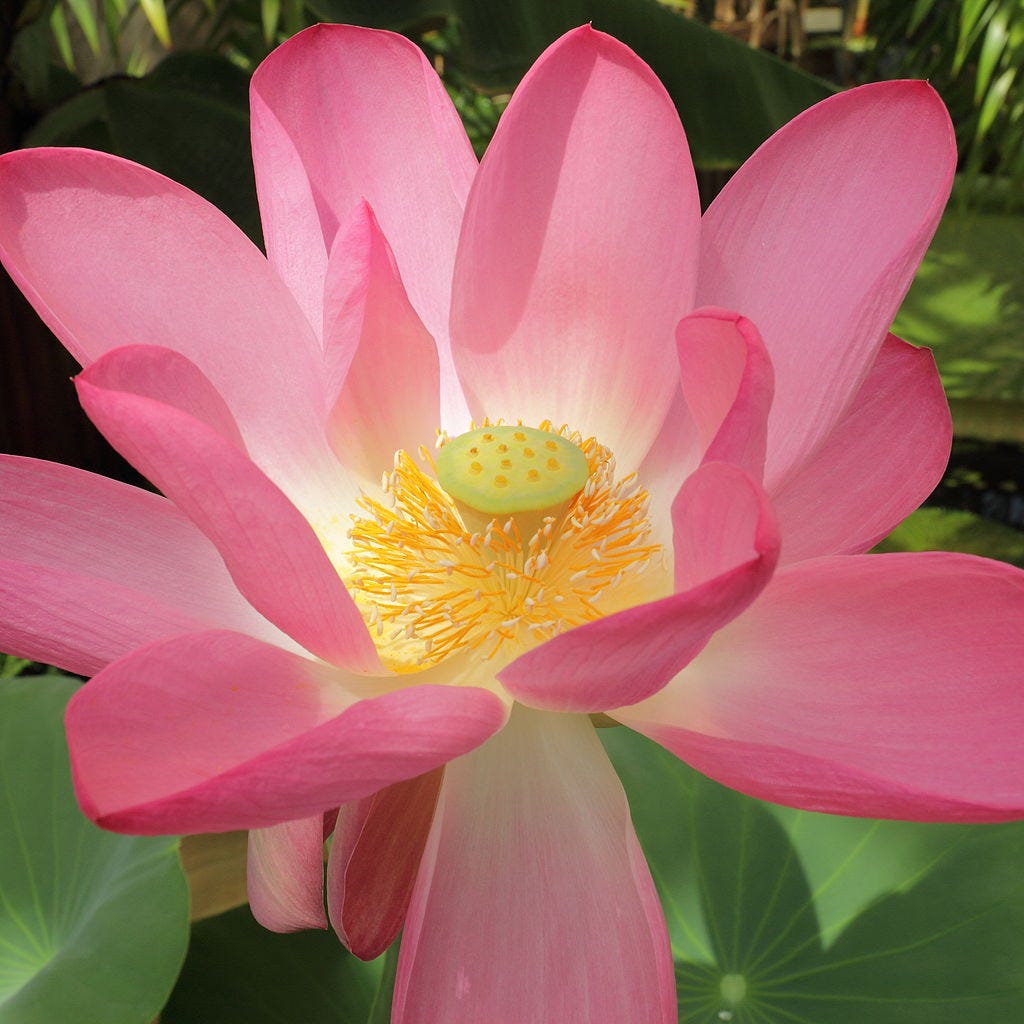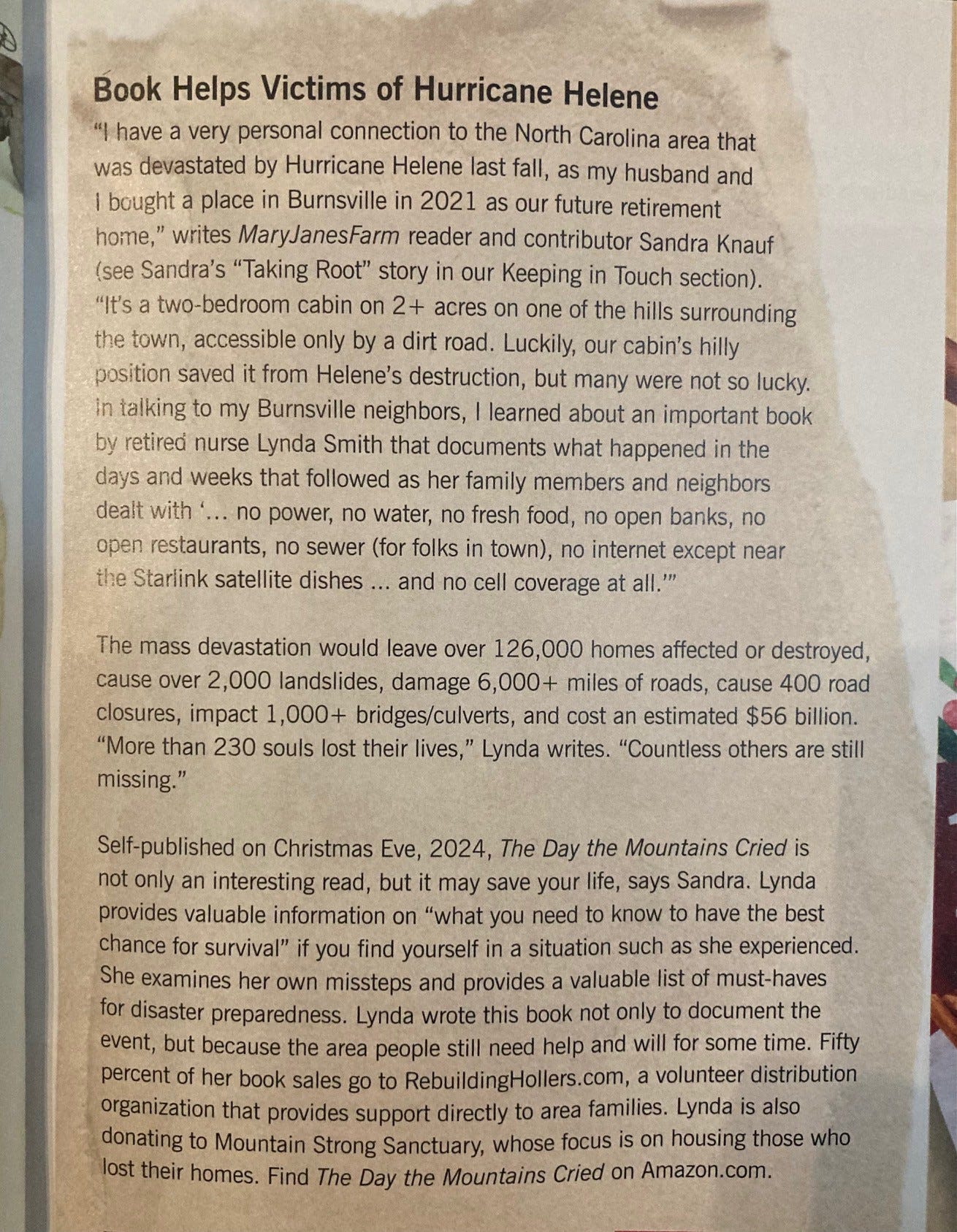Extra, Extra: Two Articles in MaryJanesFarms' Latest Issue!
One's an essay I wrote about the meaning of putting down roots, and the other is a book review of The Day the Mountains Cried by Lynda H. Smith (on surviving Hurricane Helene).
Hi everyone!
Just wanted to send you a note that two pieces I wrote for MaryJanesFarm Magazine just came out in their June/July 2025 issue. By the way, it looks like an extra-fantastic issue—I can’t wait to read it cover-to-cover like I always do!
One piece (typed below) is an essay about the meaning of “putting down roots” that I submitted this spring. I know it will resonate deeply with some of you.
I felt doubly-blessed as they also published a book review of The Day the Mountains Cried. As you may know, I’ve been very excited about this book since I read it in January and since then I’ve felt I had to do what I could to tell others! I sent MJF an email about it and they used what I sent in as a book review.
The cherry on top was that Greenwoman Substack newsletter and The Butterfly Diaries were mentioned in my bio. Thank you, MaryJanesFarm Magazine!

Everlasting Roots
As I gaze out our window at the early morning blue and pink sky, I think how the colors are like a child’s Easter egg. I’m sitting on the couch with my cup of black tea (with a little sugar and milk). Our dog Maia, a blonde wolfie-looking girl, is curled up on a distressed leather chair close by. On this morning, I contemplate roots.
What does it mean, “taking root”? I’ve been thinking it over. The first thing that came to mind was a seed or a plant growing into soil, embracing, connecting, and absorbing from that soil so it can obtain stability, nourishment and, most importantly, sustain life.
But what about the human side?
I sip my tea. Maia stirs, looks up, shuts her eyes again. For me, humans taking root brings to mind heritage, family, home. As I ponder those types of roots, I feel an old inadequacy stirring, one I know others have felt. For some of us, those types of roots bring a feeling of something missing, a longing, a desire for security and a feeling of belonging. Family, yes, and place, too—happily united! As a child of divorce I knew several step-parents, six half-siblings, and was uprooted many times in many ways (eight schools in 12 years, for one example). I felt like an outsider in comparison to kids whose parents were together, who enjoyed relationships with extended family nearby, whose homes were stable.
I then thought about the millions, perhaps billions, who have had it worse. Those who have experienced uprootedness in the worst forms: death or abandonment. As we are seeing often these days, people can lose homes and family on a massive scale nearly overnight. Some even lose their country.
As a grownup, I wanted to heal those wounds, to fill the hole. I tried hard to “take root.” At age 20, I chose to live in Colorado, far away from family roots in Missouri. Over the years I nested, first in rentals then in “real” homes, and I focused on bonding with my husband’s family. I birthed two daughters, I grew a garden. I watched all that I planted and nurtured take root and grow: children, plants, creative works, dreams.
And then one day, in my 50s, a challenge and shock came. I lost my home of three decades. I immediately felt like a child again—unrooted, vulnerable, unsafe.
But I really wasn’t unrooted. I just didn’t understand what being rooted really meant. I didn’t know that I had childhood wounds that needed healing. I didn’t know I needed to learn to love and accept myself and be okay with whatever came my way. After hard work, realizations, many tears, and several years work on myself, I discovered taking root had a different meaning.
Yes, taking root can mean creating a beautiful, cherished family, it can mean creating a loving home, it can mean creating a garden or farm that feeds body and soul. It can mean so many other things, but at its core, to me, rootedness is more than that.
As I finish my tea and the morning sun rises, I think of what a friend told me last night. In the Hindu religion, the mud which roots the lotus flower is symbolic of our own personal attachment and desires. The lotus bloom is symbolic of how something beautiful can emerge from something that is viewed as unpleasant. To me, that metaphor feels right. Taking root means accepting an everlasting rootedness, LOVE, in your very soul. The kind of roots that can never die.
And, the review of The Day the Mountains Cried!
This is the best book I’ve read this year and it has now sold around 5,000 copies (rare for most books published by big publishing houses, let alone a self-published book). In other words, it’s a grassroots success! It is doing a lot of good for people who need help. I hope you’ll buy it and share it!









